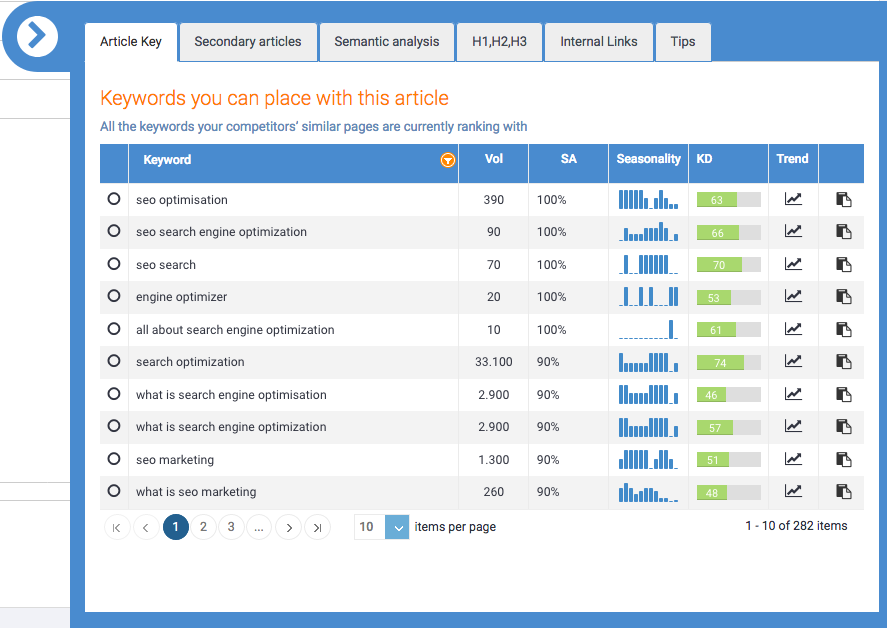Search Intent Tool – Discovering the users’ search intents
Did you ever happen to do the Keyword Research of the century? To feel super satisfied for having thoroughly dug up every single keyword concerning a specific sector and pull a big sigh of final relief?
Did you ever happen, immediately after, to analyze the huge collection of keywords and not have the slightest idea of how to manage and group them to define the editorial plan?
- How many articles do I have to write?
- How many of these keywords could be ranked with the same article?
- Which instead need a dedicated article with a specific focus?
I think this happens almost every time we finish the keyword research phase and we have to inexorably move to the action to get results with our content.
Obviously this happened to me too, until I decided to automate a series of SERP analysis processes that I used to manually do so to draw my conclusions and succeed in dividing my keyword research into keyword groups on which to focus the writing of each article.
The main problem of this activity was not so much the logical grouping but rather having the certainty of doing the right thing.
Probably my groupings made sense for me but would not have it for the search engine.
Google would probably have preferred for some particular focus on the subject to be omitted from the main article and covered in more detail in a related article.
The new SEOZoom Search Intent algorithm is born
And exactly from the analysis of Google’s behaviour we were able to create a new algorithm that can provide important insights for you to be able to make strategic decisions concerning the drafting of any article and the main focus to base it on, but most of all all on which keywords it is possible to obtain results and on which would be the case to create a secondary content.
All in all, this is what I have always wanted and that, I think, everyone has been waiting for a long time now.
Let’s look at the first data provided whenever we analyze a keyword
In the case of the keyword “Classic apple pie recipe” the new algorithm tells us immediately that it is not a Main Key, a.k.a that it is not the case to focus an article on it in order to make it rank on Google, if we want to rank with this keyword the article focused on the Main Keyword “Apple Pie recipe” will already do the job.
In the next four boxes we find very important information that will then be deepened further down the page.
- Keyword with same Intent
It is the number of keywords we could place in TOP10 with a single article on the main keyword - Main Intent total volume
The total search volume for which we could compete with just one article, the one on the main keyword. - Identified topics
It is the number of relevant terms detected by analyzing all the keywords. They represent some important focus to consider in the article. - Secondary topics
These are all the keywords you do not want to insert in the main article as the search engines currently prefer specific pages on the topic and not the main article written for the Main Key.
The summary data already represent a very interesting information but, as you know, Seozoom is made by SEOs for SEOs, so we wanted more, we wanted the details.
This section shows in detail the weight of each keyword in identifying the Search Intent.
Two very important metrics have been introduced, the first (SA) is the SERP Affinity and indicates the percentage of “similarity” of the SERP that Google shows for each keyword compared to the Main Keyword.
For instance, the keyword “How to make apple pies” has an 80% SERP Affinity, meaning that 80% of the SERP is identical to that of “Apple Pie recipe“, which means that Google has chosen 8 Urls that speak of “How to make apple pies” to rank them for “Apple Pie recipe“, too.
This shows us exactly how Google is behaving with certain types of content.
The second metric introduced is the (IC) In Content factor, that is the percentage of presence of the keyword within the text of the web pages placed in TOP 10.
In the case of “How to make apple pie” the IC factor is only 10%, so it means that it is not strictly necessary to insert this keyword in the text because Google got it itself, no small piece of information that will prevent us from stuffing our content with endless useless variants of keywords.
If you want to exclude from view all keywords that have never been used inside the texts of your competitors you can do so easily by selecting the option above the grid.
Below the same keywords identified for Main Intent, are grouped to allow you to analyze them differently and decide on which topics to focus your writing on.
The choice of correlated articles
There was another feature that I really needed, a.k.a the one able to tell me which keywords could I use to write insight or secondary articles that I also could, perhaps, link from the main article.
This tool completes the work on the Search Intent suggesting us new articles to write that will not conflict/cannibalize the main article.
For each article the number of Main Intent keywords and the potential search volume for which to compete are indicated.
Updated Editorial Assistant
And we could surely not fall short of an update to the editorial assistant: now you will also have the chance to have at your disposal all the analyses performed on the Search Intent inside our writing tool, as well.
We have added some valuable information, like the list of keywords that you would be able place with the article you are writing – “Article Key” (because others have not succeeded) – and a list of keywords that require a specific article to compete – “Secondary articles” – and that therefore you will not need to cover in the article you are writing.
My dream has come true, I hope it can be useful to everyone to always get better results with your websites 🙂








